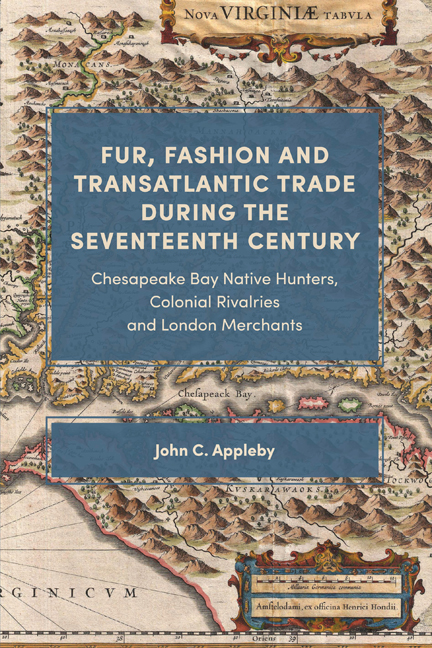 Fur, Fashion and Transatlantic Trade during the Seventeenth Century
Fur, Fashion and Transatlantic Trade during the Seventeenth Century Book contents
- Frontmatter
- Contents
- Acknowledgements
- A Note on Conventions
- Abbreviations
- Maps
- Introduction
- 1 Fur and Fashion: The Infrastructure of a New Trade
- 2 Commerce and Colonization: The Emergence of the Fur Trade in Chesapeake Bay
- 3 Trade and Rivalry: The Promise of Expansion and Innovation during the 1630s
- 4 Trade, Rivalry and Conflict during a ‘Time of Troubles’ from 1640 to 1660
- 5 Commercial Change and Conflict: Contrasting Experiences after 1650
- 6 Trade, Consumption and Industry: Transatlantic Constraints on the Bay Trade
- Conclusion
- Appendix
- Select Bibliography of Works Consulted
- Index
1 - Fur and Fashion: The Infrastructure of a New Trade
Published online by Cambridge University Press: 15 December 2020
- Frontmatter
- Contents
- Acknowledgements
- A Note on Conventions
- Abbreviations
- Maps
- Introduction
- 1 Fur and Fashion: The Infrastructure of a New Trade
- 2 Commerce and Colonization: The Emergence of the Fur Trade in Chesapeake Bay
- 3 Trade and Rivalry: The Promise of Expansion and Innovation during the 1630s
- 4 Trade, Rivalry and Conflict during a ‘Time of Troubles’ from 1640 to 1660
- 5 Commercial Change and Conflict: Contrasting Experiences after 1650
- 6 Trade, Consumption and Industry: Transatlantic Constraints on the Bay Trade
- Conclusion
- Appendix
- Select Bibliography of Works Consulted
- Index
Summary
In 1583 the puritan Philip Stubbes denounced extravagant dress in England. During the course of his vitriolic Anatomie of Abuses, he fulminated against ‘novell Inventions and new-fangled fashions’. One of his targets was the changing style of headwear. Responding to recent developments, he noted that fashion in hats was both rare and strange. They were worn in distinctive ways, dyed in various colours, and made of different materials. The fabric used in the manufacture of headwear included silk, velvet, wool, and fine hair or fur ‘far-fetched and dear bought’. Stubbes’ concern was provoked by the appearance of the beaver hat in England, which became an essential accessory during the late sixteenth and early seventeenth centuries for rich and fashion-conscious consumers. But the spread of the new fashion provoked moral reformers who insisted that clothing and accessories serve necessity not vanity. Their anger was fuelled by the use of jewellery and feathers, highlighting the distinctive qualities of the beaver, which Stubbes dismissed as unseemly emblems of pride in defiance of virtue. The exaggerated language of complaint reflected a broader battle in early modern England over the regulation and representation of the body. Unintentionally, its impact, as echoed in sermons and drama, may have strengthened the appeal of the new style in headwear across age and gender boundaries as a symbol of wealth, status and power. But the introduction of the beaver hat had unintended and far-reaching consequences. Growing demand revitalized the fur trade, at a time when European supplies were declining, encouraging traders to seek out new sources across the Atlantic. It led to the emergence of a new industry, which called for specialized skills and expertise related to wider changes in the structure and organization of feltmaking in London. Based on the domestic market, the growth of consumption and production, linked with marketing and distribution, created the socio-economic infrastructure that sustained the North American fur trade. During an early and experimental phase of seaborne expansion, it served as a driving force for wider commercial and colonial horizons. While acknowledging the deeper roots of change within an established culture of dress, this chapter examines the links between fur, fashion and consumption which established the necessary conditions for the emergence of a new transatlantic enterprise.
- Type
- Chapter
- Information
- Fur, Fashion and Transatlantic Trade during the Seventeenth CenturyChesapeake Bay Native Hunters, Colonial Rivalries and London Merchants, pp. 13 - 44Publisher: Boydell & BrewerPrint publication year: 2021


